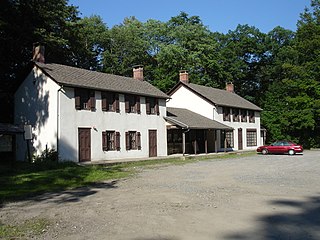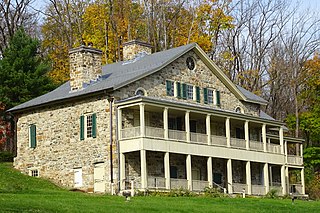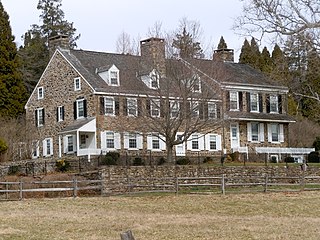Related Research Articles

Estill County is a county located in the U.S. state of Kentucky. As of the 2020 census, the population was 14,163. Its county seat is Irvine. The county was formed in 1808 and named for Captain James Estill, a Kentucky militia officer who was killed in the Battle of Little Mountain during the American Revolutionary War. Estill County is a moist county meaning that the county seat, the city of Irvine, allows the sale of alcohol after the October 9, 2013, vote, but not the rest of Estill County outside the Irvine city limits. Estill County has two adjacent towns, known as the twin cities, Irvine and Ravenna. Both cities sit along the Kentucky River in the central part of the county. Ravenna is home to a former CSX Transportation facility, now owned by Kentucky Steam Heritage Corporation for the restoration of Chesapeake and Ohio 2716. It conducts the Ravenna Railroad Festival annually in late summer, and the historic Fitchburg & Cottage Furnaces are located here. Irvine hosts the annual Mountain Mushroom Festival over the last weekend of April, which celebrates the abundant Morel Mushrooms found in the region.

Roxbury is a town in Litchfield County, Connecticut, United States. The population was 2,260 at the 2020 census. The town is located 65 miles (105 km) northeast of New York City, and is part of the Northwest Hills Planning Region.

Lewisburg is a borough in Union County, Pennsylvania, United States, 30 miles (48 km) south by southeast of Williamsport and 60 miles (97 km) north of Harrisburg. The population was 5,158 as of the 2020 census. It is the county seat of Union County. Located in central Pennsylvania's Susquehanna River Valley, on the West Branch Susquehanna River, it is home to Bucknell University. Its 19th-century downtown is listed on the National Register of Historic Places. Lewisburg is the principal city of the Lewisburg Micropolitan Statistical Area, and is also part of the larger Bloomsburg–Berwick–Sunbury Combined Statistical Area.

Whyalla is a city in South Australia. It was founded as "Hummocks Hill", and was known by that name until 1916. It is the fourth most populous city in the Australian state of South Australia after Adelaide, Mount Gambier and Gawler and along with Port Pirie and Port Augusta is one of the three towns to make up the Iron Triangle. As of June 2018, Whyalla had an urban population of 21,742, having declined at an average annual rate of -0.75% year-over-year over the preceding five years. It is a seaport located on the east coast of the Eyre Peninsula and is known as the "Steel City" due to its integrated steelworks and shipbuilding heritage. The port of Whyalla has been exporting iron ore since 1903.

Fort Knox, now Fort Knox State Park or Fort Knox State Historic Site, is located on the western bank of the Penobscot River in the town of Prospect, Maine, about 5 miles (8.0 km) from the mouth of the river. Built between 1844 and 1869, it was the first fort in Maine built entirely of granite; most previous forts used wood, earth, and stone. It is named after Major General Henry Knox, the first U.S. Secretary of War and Commander of Artillery during the American Revolutionary War, who at the end of his life lived not far away in Thomaston. As a virtually intact example of a mid-19th century granite coastal fortification, it was added to the National Register of Historic Places in 1969 and declared a National Historic Landmark on December 30, 1970. Fort Knox also serves as the entry site for the observation tower of the Penobscot Narrows Bridge that opened to the public in 2007.
Denver, formerly known as Dry Pond, is a census-designated place and unincorporated community in Lincoln County, North Carolina, United States. As of the 2010 census it had a population of 2,309.

The Tredegar Iron Works in Richmond, Virginia, was the biggest ironworks in the Confederacy during the American Civil War, and a significant factor in the decision to make Richmond the Confederate capital.

The East Broad Top Railroad (EBT) is a 3 ft narrow gauge historic and heritage railroad headquartered in Rockhill Furnace, Pennsylvania. Operating from 1871 to 1956, it is one of the United States' oldest and best-preserved narrow-gauge railroads, and was designated a National Historic Landmark in 1964. The railroad is now preserved for use as a tourist attraction until operations ceased in 2011. After a nine-year closure, in February 2020 it was announced that the railroad had been purchased by a non-profit foundation and regular train service resumed in the summer of 2021.

Long Pond Ironworks State Park is located in the community of Hewitt, in West Milford, New Jersey, United States. The park is known for its old stone walls, furnaces and other remnants of a once industrious ironworking community that now sits next to the swiftly flowing Wanaque River. The park is operated and maintained by the New Jersey Division of Parks and Forestry and has an area of 145 acres (0.59 km2).

Oxford Furnace is a historic blast furnace on Washington Avenue, near the intersection with Belvidere Avenue, in Oxford, Oxford Township, Warren County, New Jersey. The furnace was built by Jonathan Robeson in 1741 and produced its first pig iron in 1743. The first practical use in the United States of hot blast furnace technology took place here in 1834. The furnace was added to the National Register of Historic Places on July 6, 1977 for its significance in industry during the 19th century. It was later added as a contributing property to the Oxford Industrial Historic District on August 27, 1992.

The Green–Meldrim House is a historic house at 14 West Macon Street, on the northwest corner of Madison Square, in Savannah, Georgia. Built in 1853, it was designated as a National Historic Landmark in 1976 as one of the American South's finest and most lavish examples of Gothic Revival architecture. The house is owned by the adjacent St. John's Episcopal Church, which offers tours and uses it as a meeting and reception space.

The Coventryville Historic District is a historic district and historic village in Chester County, Pennsylvania, United States that enjoyed a significant role in the early American metal industry.

The Elkridge Furnace Complex is a historic iron works located on approximately 16 acres (6.5 ha) at Elkridge, Howard County, Maryland.

The Oregon Iron Company Furnace, or Oswego Iron Furnace, is an iron furnace used by the Oregon Iron Company, in Lake Oswego, Oregon's George Rogers Park, in the United States. The structure was added to the National Register of Historic Places in 1974 and underwent a major renovation in 2010. The current furnace is the only structure that remains of the original iron company, and is the oldest industrial landmark in the state of Oregon.

The Clinton Furnace, also known as the Clinton Ironworks, is located along Clinton Road at the base of the Clinton Reservoir by the Clinton Brook in the township of West Milford in Passaic County, New Jersey, United States. The furnace was built in 1826 and was added to the National Register of Historic Places on June 18, 1976, for its significance in industry. The furnace is the last surviving structure of the iron community once known as Clinton.

Shippen Manor is located in Oxford Township, Warren County, New Jersey, United States. The manor was built in 1755 and was added to the National Register of Historic Places on December 20, 1984, for its significance in architecture and industry. It was later added as a contributing property to the Oxford Industrial Historic District on August 27, 1992.

The Warwick Furnace Farms is a historic district that is located in northern Chester County, Pennsylvania, United States that includes the ruins of an early iron furnace that was owned by Anna Rutter Nutt, widow of Samuel Nutt.

The Swatara Furnace is a historic iron furnace and 200-acre national historic district located along Mill Creek, a tributary of the Swatara Creek in Pine Grove Township, Schuylkill County, Pennsylvania.

The Reading Furnace Historic District is a national historic district that is located in Warwick Township and East Nantmeal Township, Chester County, Pennsylvania.
Vesuvius Furnace is a historic home and iron furnace located between Denver and Iron Station, Lincoln County, North Carolina. The house was built in two sections the older dated to about 1792, with the western section added about 1810–1820. It is a two-story, five bays wide and two deep, frame structure with a one-story shed porch. The furnace was built in 1790, and is constructed of large stone blocks of random sizes, but about half of the square pyramidal structure has fallen down. The furnace is about 20 feet high and is filled with dirt, debris, and vegetation. Vesuvius Furnace was established by General Joseph Graham, who was one of the chief leaders in the 18th and early 19th century production of iron in Lincoln County, and was the father of governor and as secretary of the navy William Alexander Graham.
References
- ↑ Chapman, Matt (October 5, 2018). "Local iron furnace may be included in National Register". Lincoln Times News. Retrieved November 5, 2021.
- 1 2 3 "Madison-Derr Iron Furnace – Lincoln County Historical Association". www.lincolncountyhistory.com. Retrieved November 5, 2021.
- ↑ Lesley, Peter (1866). The Iron Manufacturer's Guide to the Furnaces, Forges and Rolling Mills of the United States. Creative Media Partners, LLC. ISBN 978-1375516600.
- ↑ Writer, Jaclyn Anthony Staff (March 2019). "Madison-Derr furnace added to national register". Lincoln Times News. Retrieved November 5, 2021.
- ↑ "weekly list 20190201 (aggregate list) - National Register of Historic Places (U.S. National Park Service)". www.nps.gov. Retrieved November 5, 2021.